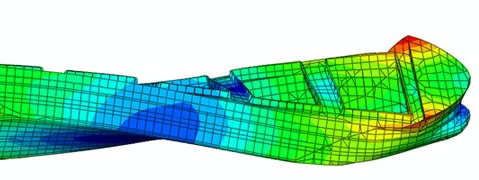Hydroelastic vibrational aspects of fluid-structure interaction simulations...
Vibration is a very important matter affecting people’s comfort, equipments’ operations and needs to be investigated through analyses at design stage.

Advanced Engineering > Fluid-Structure Interaction
Hydroelastic Vibration Analyses
The design of a ship construction without any excessive vibration is an important matter and needs to be investigated through analyses in the design stage. Three dimensional finite element method is a common procedure to obtain the ship's main vibration characteristics. Therefore, resonance frequencies can be obtained and through forced vibration analysis, the peak values of the displacements, velocities or accelerations can be checked with ISO standards.

Hydroelastic Vibration Analysis
(20000 DWT Bulk Carrier)
Watch the video


Hydroelastic Vibration Analysis
(32000 DWT Bulk Carrier)
Watch the video


Hydroelastic Vibration Analysis
(53000 DWT Bulk Carrier)
Watch the video


Hydroelastic Vibration Analysis
(180000 DWT Bulk Carrier)
Watch the video


Hydroelastic Vibration Analysis
(180000 DWT Bulk Carrier)
Watch the video


Hydroelastic Vibration Analysis
(1900 TEU Container Ship)
Watch the video


Hydroelastic Vibration Analysis
(1900 TEU Container Ship)
Watch the video


Hydroelastic Vibration Analysis
(Research Vessel)
Watch the video


Hydroelastic Vibration Analysis
(4750 DWT Chemical Tanker)
Watch the video


Hydroelastic Vibration Analysis
(15000 DWT Chemical Tanker)
Watch the video

The excitations induced by the propulsion system are the main source of the ship vibrations. These excitations from the propulsion system can be seen in can occur in several ways. Dynamic forces such as thrust and moment variations from the propeller are transmitted to the hull through shaft bearings. The propeller induced fluctuating pressures on the hull surface induces vibration on the ship structure. The main and auxiliary engines can excite the ship's natural frequencies through dynamic forces transmitted from the foundations and supports. These excitations can cause the vibration of the hull girder, deckhouses, local structures and equipment. The order of the excitation frequencies from the propulsion system can be shaft rotational frequency (RPM), blade frequency and their harmonics. The main engine induced unbalanced excitations for the slow speed diesel engines are the first and second order external forces and moments.
The response of the hull structure may be resonant or non-resonant.



















The hull structure will normally vibrate in the following modes;
- Vertical Bending Modes
- Horizontal Bending Modes
- Torsional Modes
- Longitudinal Modes
- Coupling Modes between the Horizontal and Torsional Modes
21.11.2011
We are participating to Abaqus Turkey Users Meeting.
Abaqus Turkey Users Meeting, of which Mesh Engineering & Software Co. is a regular participant, is going to be held on 17th-18th November 2011 in Istanbul Byotell.
Details. >>
Related References
- MSH-FSI-005, 53000 DWT Bulk Carrier, 2009
- MSH-FSI-004, 32000 DWT Bulk Carrier, Cihan Denizcilik San. ve Tic. Ltd.Şti., 2009
- MSH-FSI-003, 20000 DWT Bulk Carrier (Eylül K), İleri Denizcilik ve Ticaret A.Ş., 2009
- MSH-FSI-002, 180000 DWT Bulk Carrier, Turkon Konteyner Taşımacılık ve Denizcilik A.Ş., 2007
- MSH-FSI-001, 1900 TEU Container Ship (Mukaddes Kalkavan), Turkon Konteyner Taşımacılık ve Denizcilik A.Ş., 2006
- All References >>





